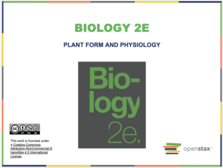Description
- Overview:
- Plants are as essential to human existence as land, water, and air. Without plants, our day-to-day lives would be impossible because without oxygen from photosynthesis, aerobic life cannot be sustained. From providing food and shelter to serving as a source of medicines, oils, perfumes, and industrial products, plants provide humans with numerous valuable resources. When you think of plants, most of the organisms that come to mind are vascular plants. These plants have tissues that conduct food and water, and they have seeds. Seed plants are divided into gymnosperms and angiosperms. Gymnosperms include the needle-leaved conifers susch spruce, fir, and pine. Their seeds are not enclosed by a fleshy fruit. Angiosperms, also called flowering plants, constitute the majority of seed plants. They include broadleaved trees (such as maple), vegetables (such as potatoes), grasses, and plants known for the beauty of their flowers (roses and daffodils, for example). In this module we will be exploring the different structures found within plants, the different physiological processes performed by plants, the different mechanisms of transport that occur within plants, and various response mechanisms used by plants.
- Subject:
- Biology
- Level:
- Community College / Lower Division, College / Upper Division, College Credit Plus
- Material Type:
- Module
- Provider:
- Ohio Open Ed Collaborative
- Date Added:
- 05/23/2019
- License:
-
Creative Commons Attribution Non-Commercial Share Alike

- Language:
- English
- Media Format:
- Downloadable docs, Text/HTML
Standards
Evaluations
No evaluations yet.


Comments